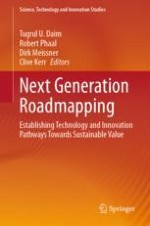Roadmapping is a structured visual approach for supporting strategic technology and innovation management, providing strategic navigational support (hence the “roadmap” metaphor) for technologists, designers, entrepreneurs, programme managers, executives, policy makers, other stakeholders involved in the formulation and implementation of strategy.
This book brings together the latest developments in roadmapping, covering a range of practical issues and conceptual aspects. First, the book delves into the critical topic of strategic alignment within organizations, encompassing the interdependencies and synchronization of horizontal and vertical systems, connecting innovation priorities to strategic objectives, and the integration of key performance indicators. Then, the book concentrates on practical techniques and tools for roadmapping, including a template-based approach for technology venture funding. Social and digital aspects of roadmapping are explored, including workshop methods, considering how quantitative (analysis) and qualitative (expert) knowledge can be combined for improved strategic planning. Finally, a series of new case studies focusing on energy systems in Sub-Saharan Africa and Turkey illustrate the practical application of technology roadmapping and also provide useful insights.
Roadmapping continues to evolve, as it is adapted to apply to new domains and strategic challenges, propagates to new sectors, and as new digital technologies such as AI emerge that radically affect strategy and innovation processes. The need for structured and engaging approaches such as roadmapping for navigating towards the future is essential.
